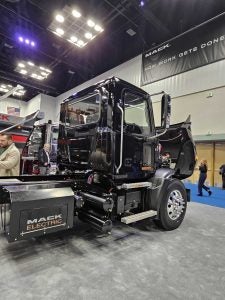If you want to get a clear picture of where an industry’s biggest players think the market is headed, go to their annual trade show. I attended Work Truck Week 2023 in Indianapolis this week, and the picture was unmistakable: Work trucks are going electric. Now’s the time for fleet managers and state and local leaders to develop roadmaps to navigate and manage this transition.
Electric trucks are ready to roll
In years past, truck manufacturers used Work Truck Week to introduce the very concept of electric trucks. I remember just a couple of years ago a bare electric chassis attracted crowds like it was a science fair display of some futuristic fantasy. This week, I saw dozens of actual electric work trucks on the floor, ready for customers and ready to hit the road. Mack — one of the most iconic big truck brands in the world – used the tradeshow to introduce its electric Class 6-7 model.
Electric trucks still make up a small percentage of trucks on the road, but that’s changing quickly as more truck models are announced. There’s a zero-emission model for nearly every class and use case, and orders of zero-emission trucks have been increasing steadily for a few years. A recent report by Rhein Associates and ACT Research projects electric truck production to increase 300% in 2023 alone.
The market is responding to fleet demand
Truck manufacturers and component suppliers are investing billions of dollars to meet this growing demand.
At Work Truck Week 2023, electric trucks are picking up speed Share on XThough many fleets are motivated by climate and clear air benefits, it’s the quality and capability of these vehicles that are driving the market. Having had a few years to learn and test electric trucks, fleet leaders are recognizing that it’s time to scale the transition, even in some of the more challenging applications. Republic Services is an important case-in-point. The leading refuse hauler recently announced that 50% of its truck purchases would be electric by 2028.
A year or two ago, fleet leaders were curious about how electric trucks perform and skeptical that these vehicles were well suited for their needs. The conversation has shifted. This year at the Work Truck Show, fleet leaders were pushing on manufacturers to provide more flexibility so fleets can upfit the trucks to a much wider range of applications.
It’s also very clear that, as good as the electric trucks are today, even better models are coming in the near-future. The growing importance of E-axles is one example. E-axles have the electronic motor directly connected to the drive axle, which increases efficiency and reduces weight for battery electric trucks. Many manufacturers spoke this week about new E-axle products they are bringing to market and promising fleets improved performance and reduced costs.
The important role of public policy
Time and again over the conference, fleets and manufacturers noted the critical role that public policy has played in moving the market to where it is and the vital need for policies that will help fleets move further, faster.
Not surprisingly, The Inflation Reduction Act was a popular topic. The IRA provides billions in rebates and tax credits to spark demand for zero-emission trucks and reduce the cost of charging infrastructure, including a new $40,000 tax credit for zero-emission commercial vehicles, $100,000 per charging item installed at a depotand a $1 billion grant program through EPA for clean class 6 and 7 trucks. And it includes billions more to support the build-out of infrastructure for trucks and buses across the nation. There was also recognition of the importance of long-term emission standards and state programs, such as the Advanced Clean Trucks rule adopted by seven states.
More progress ahead
It’s amazing how far electric trucks have come in just the past couple of years. And though the momentum within the truck industry is unmistakable, there’s still a lot of work to be done to scale up the production and adoption of these vehicles. The good news is that we know what needs to be done and that there is broad recognition of where we need to go.
I heard one phrase over and over this week: the messy middle. It’s a concept from the North American Council on Freight Efficiency that recognizes the trucking industry is undergoing a transition unlike any other in its history. The industry has left behind a past that was dominated by a single, high-polluting fuel and is heading for a future that is dominated by zero-emission solutions. Along that path is a lot of hard work – the messy middle. As we move forward on this journey, it’s imperative that all stakeholders stay committed to doing the hard work to bring forward the better future we seek. Following Work Truck Week, it’s clear to me that many fleet leaders recognize the importance and challenges of the task ahead and are ready to do their part. Their commitment is electrifying.










